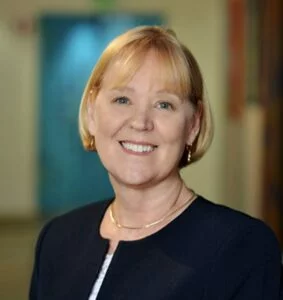As mergers and acquisitions continue to rock the healthcare industry, organizations are faced with critical decisions, particularly when it comes to leadership. Consequently, more are turning to interim leaders to hold down the fort.
“There’s a lot going on right now,” said Judy Kirby, Executive Recruiter at Kirby Partners. “We’re seeing a lot of individuals back on the marketplace looking for opportunities,” and a lot of hospitals that need a stopgap.
It has the potential to be a win-win situation. However, while the qualities teams look for in interim and permanent CIOs are relatively similar, there are nuances to each that require a different approach.

Judy Kirby
During a recent Keynote interview, Kirby and Christopher Scanzera, who recently served as Interim CIO at Lurie Children’s Hospital, shared insights on why organizations opt for temporary leaders and the skills they value most in these individuals. They also offered advice that can be leveraged by all healthcare leaders as the landscape continues to evolve.
Kirby, who has more than three decades of experience in the field, believes that while M&A has undoubtedly played a role in the surge of interim roles, there are also other key factors. “I think organizations are asking, ‘do we have the right person in the chair?’” she noted.
Another key element is the circumstances under which the predecessor left, and the time that has lapsed since. In some cases, an internal person might be available to fill the role, at least on a temporary basis, but the reality is that most organizations lack a solid succession plan.
In some cases, however, the absence of CIO presents an opportunity to assess the current strategy and make adjustments, according to Kirby. “A lot of organizations, especially now, aren’t sure what they need in their next technology leader. Where are they going with digital? Where are they going with AI and cloud? I think sometimes having that interim come in and give an independent assessment can help level-set for where they need to be going.”
One of the questions Kirby’s team often gets is what to look for in an interim leader. And while there isn’t a universal answer, she places high value on individuals with a consulting background, as well as those who have previously helped interim roles. “They’re going to be a little more successful because they’re got a playbook coming in,” she said.

Chris Scanzera
Scanzera, who spent time with Deloitte and PriceWaterhouseCooper before becoming CIO at AtlantiCare, believes that his consulting experience benefited him significantly. But what’s really important is the ability to “deal with uncertain situations and size things up very quickly,” he stated. “You need political acumen, especially if you’re walking into an organization where someone who was loved as a CIO departed. You have to understand the political temperatures of not just the C-Suite, but also the IT executive team.”
And while technical knowledge will certainly come in handy, the ability to communicate effectively across multiple levels is even more vital. “You’re going to get hit with a lot of different questions. One afternoon you may have to wear the CTO hat, another you might have to put on the hat of a cybersecurity leader or VP of applications,” he noted. “You need to be able to go across different domains and occasionally go deep.”
Once an individual lands an interim role, the next question (another one Kirby hears often) is, what’s the best approach? Her answer is simple: “You need to take this job and own it. Treat it like it’s your own,” she said. “Trust that you’re ready for the job and can do the job.”
Doing so, however, requires knowledge, much of which is gained during the interview process. Smart candidates, said Scanzera, are always “taking notes and learning to get a sense of what the real scoop is going to be.”
That scope might entail keeping the trains running, or it could be “a situation in which they want you to come in and make aggressive changes,” or help prepare the organization for transformation, he noted. “It’s all part of the walking tour to find out where everybody is, because you’re going to get multiple opinions and multiple wishes, desires, and interests in terms of direction.”
At the same time, it’s important to come in with a roadmap of what you’d like to accomplish, said Scanzera, who advised breaking it into two-week chunks. “You have to come in with a structured framework and mindset of listening, learning, and assimilating very rapidly.”
Unlike with a permanent role, interim roles don’t tend to have a “honeymoon period,” which can ratchet up the pressure to deliver results. “You have to hit the ground running and come in with a preconceived notion of what you’re going to do – and do that very quickly.”
The key to that, according to Scanzera, is creating a healthy culture. “For one reason or another, you have a somewhat fragmented situation, and there’s an element of trust that has to be rebuilt,” he said. “You have to go down the path of learning and respecting the institutional knowledge.”
The more transparency and authenticity a leader can bring to the table, the easier it will be to make decisions that lead to early wins, he noted. “You want to be open and be accessible, and when you get wins, you want to share the credit. As an interim CIO, you absolutely need to do that.”
Just as critical, of course, is establishing rapport with the C-suite and Board, which requires communication – ideally in the form of “structured and relevant updates,” Scanzera added. “I believe results move at the speed of relationships. The more durable you can build them, the better off you’re going to be. That, to me, is the difference between success and failure.”
Above all, CIOs – whether temporary or permanent – must continue to build their skills, and not just technical, according to Kirby, who believes emotional and social intelligence is what separates good from great leaders. “The ability to listen, talk beyond the bits and bytes, and understand the business – to me, those are the most important things.”
Scanzera concurred, noting that the focus should remain the same, regardless of how long an individual has been (or will be) in the seat. “When you’re the interim CIO, you are the de facto CIO; the role, the responsibility, the fiduciary duties are the same,” he said. “You get up every morning and give it 110 percent. The job is still the job.”


Questions about the Podcast?
Contact us with any questions, requests, or comments about the show. We love hearing your feedback.

© Copyright 2024 Health Lyrics All rights reserved